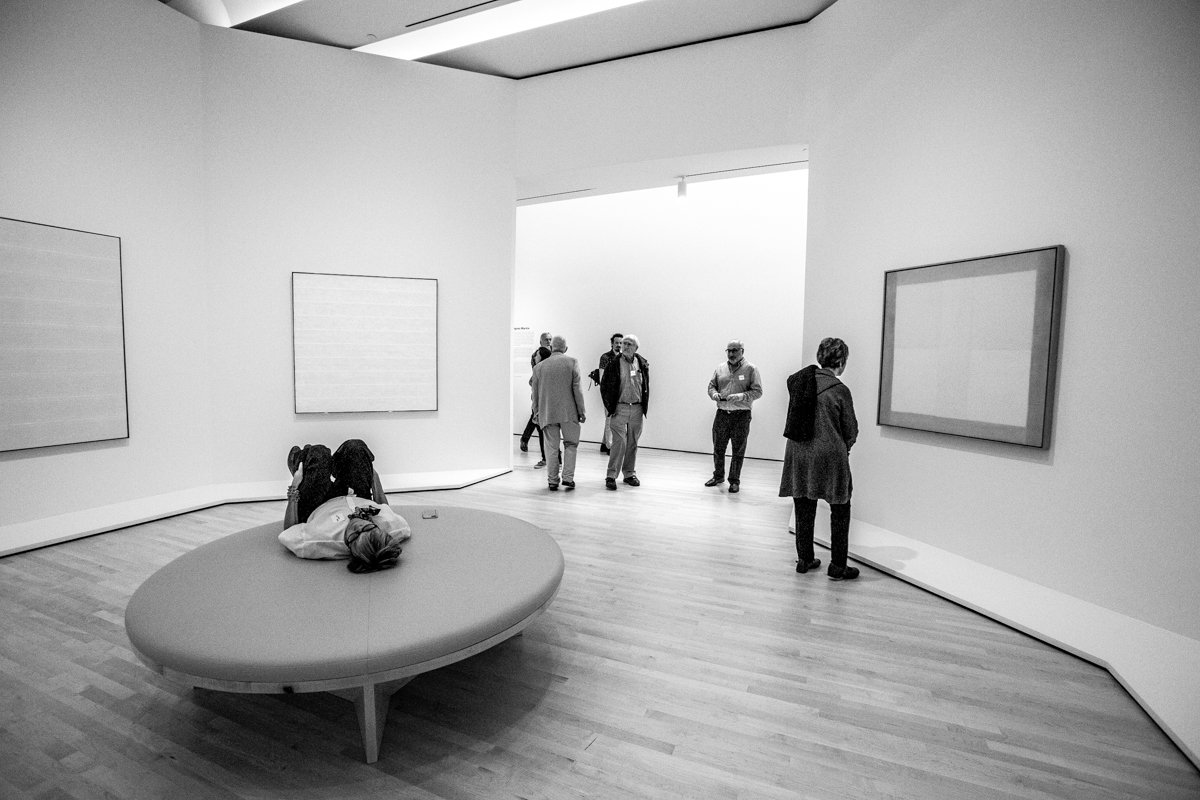Ideally I prefer presenting my photographs in groups having a common theme. The goal being to create a narrative as opposed to throwing together a hodgepodge of unrelated images expecting to gain viewer attention. The subject of this particular collection is pretty simple: people viewing works of art in a museum, in this case the San Francisco Museum of Modern Art. SFMOMA is a favorite of mine. With collection space of 170,000 square feet it is one of the largest museums in the United States overall, and one of the largest in the world for modern and contemporary art. It is also one of the first museums to recognize photography as an art form. And to be really honest, it is also a favorite of mine because they allow anyone to bring a camera with them and photograph inside as long as they behave themselves and don’t use flash. How fair is that?
I offer the following advice to all neophyte street photographers. If pointing your camera at strangers on city streets makes you nervous, practice overcoming your fears at an art museum. If you are anywhere near San Francisco, I highly recommend SFMOMA as your go-to training ground. You will not be alone. There are many people with cameras or cell phones busily snapping away at works of art. There may even be a few like myself who are more committed to capturing the people as they capture . . . well, whatever it is that they capture. Who’s to argue if you’re photographing a canvas of Chuck Close or a canvas of Chuck Close with some interesting subjects that happen to be in Chuck’s vicinity.
And if that weren’t enough, consider the advantage of diffused lighting which is part of the full package. Almost every wall at SFMOMA is white. Many areas are illuminated by large windows. It can be high noon outside with no clouds, a very unflattering light for photographing people. A perfect time to be in an air conditioned museum with well-lit subjects, wandering about looking at art. They are not at all interested in you or your camera. There is even a restaurant and bar on the first level if you need to fuel yourself with a glass of wine or a quick cocktail.
For those of you who’ve managed to read this far, I commend you. I do like to digress and easily get carried away. I’m a little late with my warning, but for future reference, you are more than welcome to just skip and head straight for the photos. None of this will be on the test.
If you are the sort of person like myself and take warnings lightly, I shall digress a bit further and mention that I prefer to pick unique titles for these collections whenever possible. I could have called this grouping, Photographs from SFMOMA, but I didn’t.
Don’t feel bad in case you missed it, but 2024 was the 150th anniversary of Modest Mussorgsky’s Pictures at an Exhibition. Originally written and first performed for solo piano, it was later orchestrated by a number of modern composers of which the Ravel version (1922) is the most frequently performed. What better title for my collection.
Here is a video for you: The Youth Orchestra of the United States of America, Carnegie Hall, 2014, David Robertson, Conductor:
Another fun fact: In 1971, Emerson, Lake and Palmer, an English progressive rock group released an album with the live concert recording of their adaption of the Mussorgsky composition. For those of you too young and who might have thought that Emerson, Lake and Palmer was a legal firm, let me note that they were quite popular in the Seventies and most deservedly so. If the Ravel adaptation fails to grab you, have a look at this one . . . and then you can go to the pictures. Class is dismissed.



















